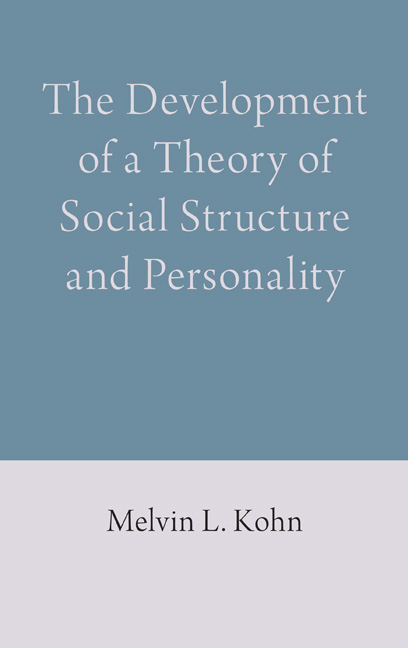Book contents
- Frontmatter
- Contents
- Preface
- 1 Hagerstown and Schizophrenia
- 2 Social Stratification and Parent–Child Relations in Washington, DC
- 3 The Torino Study
- 4 Men Employed in Civilian Occupations in the United States
- 5 The Transformation of the Occupations Study into a Longitudinal Analysis
- 6 Life on Sabbatical Leave in Norway and at the National Institute of Mental Health
- 7 Class, Stratification, and Personality
- 8 Poland under Communism
- 9 Occupational Self-Direction and Distress in Poland
- 10 The Vietnam War, Nixon, and Me
- 11 Japan
- 12 Germany – West and East
- 13 Poland and Ukraine in Transition to Capitalism and Democracy
- 14 The Presidency of the American Sociological Association, Ronald Reagan, and My Job Switch
- 15 My Two Exploratory Expeditions to China
- 16 China in Transition to a Modern Economy
- 17 Retirement, and My Last Sabbatical, at Deep Springs Junior College
- 18 The Theory I Propose
- Index
7 - Class, Stratification, and Personality
Published online by Cambridge University Press: 12 July 2019
- Frontmatter
- Contents
- Preface
- 1 Hagerstown and Schizophrenia
- 2 Social Stratification and Parent–Child Relations in Washington, DC
- 3 The Torino Study
- 4 Men Employed in Civilian Occupations in the United States
- 5 The Transformation of the Occupations Study into a Longitudinal Analysis
- 6 Life on Sabbatical Leave in Norway and at the National Institute of Mental Health
- 7 Class, Stratification, and Personality
- 8 Poland under Communism
- 9 Occupational Self-Direction and Distress in Poland
- 10 The Vietnam War, Nixon, and Me
- 11 Japan
- 12 Germany – West and East
- 13 Poland and Ukraine in Transition to Capitalism and Democracy
- 14 The Presidency of the American Sociological Association, Ronald Reagan, and My Job Switch
- 15 My Two Exploratory Expeditions to China
- 16 China in Transition to a Modern Economy
- 17 Retirement, and My Last Sabbatical, at Deep Springs Junior College
- 18 The Theory I Propose
- Index
Summary
We have come to the final portion of our longitudinal analyses of the United States – bringing social stratification back into play, defining social class more rigorously than in our previous usages, and bringing social class very decidedly into the analyses. Our main theme throughout much of this book has been the relationships of class and stratification, through job conditions, as affecting and being affected by personality. We are now ready for a reassessment of these relationships, with much more powerful methods than were available heretofore and with a much clearer differentiation of class and stratification.
In these analyses, I was joined by Carrie Schoenbach.
Carrie and I began by making a sharp distinction between social class and social stratification, for we thought that while both of them are valuable, the distinction between them must be thoughtfully made. By social stratification, we relied on the Weberian tradition of conceiving society as embodying a single dimension of differentiation, indexed by some combination of occupational status, educational attainment, and job income. In this usage, informed by the work of Donald J. Treiman, we combined the three by factor analysis, essentially a linear combination of the three component variables. By social class, we relied on the Marxist tradition of conceiving society, not as embodying a single dimension of differentiation, but as consisting of distinct social categories, based on the combination of such economic distinctions as being an owner or an employee, having a supervisor or supervisees, and, for nonsupervisory employees, whether they were manual or nonmanual workers. In the Marxist conceptualization, instead of a single dimension of differentiation, there are several dimensions of differentiation, a product of the interaction of these criteria. Here we rely primarily on the work of Erik Olin Wright.
We decidedly do not compare class to stratification with any intent of deciding which is true. We strongly believe that these concepts, like all concepts, are in the minds of the analysts, and both can be true. We attempted to learn what we could by the combined use of the two concepts.
In this research, we again made use of our precious longitudinal data to greatly extend the analyses we earlier did of social stratification. We of course used the new methods of linear structural equation analysis. Unfortunately, though, this analysis must be limited to men, for we have only cross-sectional data for the women.
- Type
- Chapter
- Information
- Publisher: Anthem PressPrint publication year: 2019



